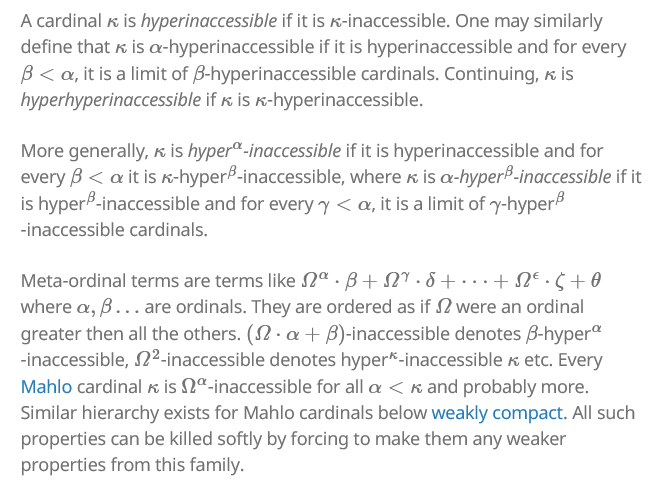Inaccessible Cardinal
In set theory, specifically in the branch known as mathematical logic, "inaccessible cardinals" are a type of large cardinal, which is a cardinal number with certain properties that make it "large" compared to the standard cardinal numbers used in everyday mathematics.
A cardinal number represents the size or "cardinality" of a set. For example, the cardinality of the set {1, 2, 3} is 3. In the context of inaccessible cardinals, we are dealing with cardinal numbers that possess certain characteristics.
An inaccessible cardinal is a cardinal number that is:
- Regular: A cardinal is regular if it is not the union of smaller cardinals. Inaccessible cardinals are regular; they cannot be expressed as the union of sets whose sizes are strictly smaller.
- Strongly Limit: An inaccessible cardinal is strongly limit. A cardinal is strongly limit if for every cardinal λ less than the given cardinal, the power set of λ has cardinality less than the given cardinal.
- Inaccessible to Power Set Operation: If κκ is an inaccessible cardinal, then 2^κ (the power set of κ) is strictly less than κ.
The term "inaccessible" is used because these cardinals are so large that they cannot be reached by certain set-theoretic constructions within the standard framework of Zermelo-Fraenkel set theory with the axiom of choice (ZFC). Inaccessible cardinals have important implications in set theory, particularly in the study of large cardinal axioms and their consistency with the standard axioms of set theory. They provide a way to explore the limitations and structure of the set-theoretic universe.
Weakly inaccessible cardinal
A weakly inaccessible cardinal is a large cardinal number in set theory that possesses certain properties making it "large" in comparison to the standard cardinal numbers used in everyday mathematics. Weakly inaccessible cardinals are a less strong form of inaccessibility compared to inaccessible cardinals.
Here are the key properties of a weakly inaccessible cardinal:
- Regular Limit Cardinal: A weakly inaccessible cardinal, often denoted as κ, is a regular limit cardinal. "Regular" means that κ is not the union of any smaller cardinals, and "limit" implies that κ is a limit ordinal, meaning there is no cardinal number λ<κ such that the set of all smaller cardinals less than λ is cofinal in κ.
- Weakly Inaccessible to Power Set Operation: A cardinal κκ is said to be weakly inaccessible if 2λ<κ for every cardinal λ<κ. This property is weaker than the corresponding property for inaccessible cardinals, as it only requires that the power set operation doesn't immediately reach κ.
While weakly inaccessible cardinals are not as strong as inaccessible cardinals, they still provide interesting insights into the structure and hierarchy of the set-theoretic universe. These cardinals are used in the study of large cardinal axioms and the exploration of the limits of what can be expressed within the standard framework of Zermelo-Fraenkel set theory with the axiom of choice (ZFC).

Levy collapse
The Levy collapse is a mathematical construction used in set theory to create certain types of forcing extensions of a given model of set theory. Forcing is a technique to investigate the independence of statements within set theory from the standard axioms. The Levy collapse specifically involves collapsing a cardinal to a countable level, thus modifying the cardinality of certain sets in the model.
Here is a basic overview of the Levy collapse:
- Generic Extension: The Levy collapse is associated with a particular forcing notion, typically denoted as Col(ω,κ) where ω is the set of natural numbers and κκ is a cardinal. This forcing adds new functions from ω to κ.
- Basic Idea: The intuition behind the Levy collapse is to "collapse" the cardinal κ to be countable. In other words, after the collapse, κ behaves as if it were countable, even though it remains uncountably large from the external perspective.
- Generic Filter: A generic filter for Col(ω,κ) is a subset of the forcing notion that satisfies certain conditions. The existence of such a filter ensures that the generic extension, obtained by forcing with Col(ω,κ) satisfies certain properties.
- Collapsing Function: The Levy collapse provides a canonical way to define a collapsing function f:κ→ωf:κ→ω in the generic extension. This function witnesses the collapsing of κ to ω within the extension.
- Applications: The Levy collapse has been used to prove various results in set theory. For example, it has been employed to show the consistency of the existence of certain large cardinals (assuming the consistency of ZFC, the standard axioms of set theory).
The Levy collapse is a fundamental tool in forcing techniques, allowing mathematicians to investigate the consequences of modifying the cardinality of sets within a given set-theoretic universe.

Inaccessible to reals
The term "inaccessible to reals" typically refers to a certain type of cardinality in set theory, where the size of the set of real numbers is compared to the size of certain large cardinals. In the context of set theory, cardinals are used to measure the size or cardinality of sets.
An inaccessible cardinal is a large cardinal that is, in a sense, unreachable by certain set-theoretic constructions within the standard framework of Zermelo-Fraenkel set theory with the axiom of choice (ZFC). The term "inaccessible to reals" is often used in the context of studying the relationship between the cardinality of the set of real numbers (R) and the existence of inaccessible cardinals.
Specifically, an inaccessible cardinal κκ is considered inaccessible to reals if the cardinality of the set of real numbers, denoted as 2ω or c, is strictly less than κκ. In other words, there are more possible subsets of the natural numbers than there are real numbers.
This concept is significant in the study of large cardinal axioms and their consistency with the standard axioms of set theory. It provides a way to investigate the limitations and structure of the set-theoretic universe by examining the relationship between the cardinality of the continuum and the existence of certain large cardinals. The existence of an inaccessible cardinal that is inaccessible to reals has implications for the complexity of the set-theoretic universe and the possible cardinal characteristics of R.

Degrees of inaccessibility
The term "degrees of inaccessibility" refers to a hierarchy of large cardinals in set theory, each associated with a specific level of inaccessibility. These cardinals exhibit increasing levels of unreachability or "inaccessibility" through set-theoretic constructions within the standard framework of Zermelo-Fraenkel set theory with the axiom of choice (ZFC).
The hierarchy typically includes the following degrees:
- Weakly Inaccessible Cardinals: These are cardinals that are regular limit cardinals and are weakly inaccessible to the power set operation. Weakly inaccessible cardinals are the lowest level in this hierarchy.
- Inaccessible Cardinals: These are the next level of inaccessibility and possess stronger properties compared to weakly inaccessible cardinals. Inaccessible cardinals are regular limit cardinals, strongly limit cardinals, and are strongly inaccessible to the power set operation.
- Mahlo Cardinals: These are cardinals that extend the inaccessibility properties further. A Mahlo cardinal is an inaccessible cardinal with the additional property that its set of regular cardinals forms a stationary set.
- Weakly Compact Cardinals: These are cardinals with properties beyond Mahlo cardinals. Weakly compact cardinals are inaccessible and have a specific compactness property with respect to certain types of partitions of the cardinal.
- Indescribable Cardinals: These cardinals are characterized by a degree of inaccessibility that makes them "indescribable" in a precise set-theoretic sense. They are often associated with certain types of definability properties.
- Reflecting Cardinals: Reflecting cardinals are characterized by their ability to reflect certain set-theoretic properties down to smaller cardinals. This involves a form of self-referentiality in the reflection of set-theoretic properties.
The hierarchy continues with even stronger large cardinals, such as measurable cardinals, strong cardinals, supercompact cardinals, etc. Each level in the hierarchy represents an increase in the degree of inaccessibility, with cardinals at higher levels possessing stronger and more intricate set-theoretic properties.
The study of degrees of inaccessibility is part of the broader investigation into large cardinals and their role in understanding the consistency and structure of set theory. These large cardinals provide a means to explore the limits of what can be expressed and proved within the standard set-theoretic framework.

Hyper-inaccessible and more
The terms "hyper-inaccessible" and similar expressions are often used to describe cardinals in set theory that go beyond the classical hierarchy of inaccessible cardinals. These cardinals are characterized by possessing stronger inaccessibility properties and are part of the broader study of large cardinals.
- Hyper-Inaccessible Cardinals: These are cardinals that go beyond the properties of standard inaccessible cardinals. A hyper-inaccessible cardinal is a strongly inaccessible cardinal κ such that for any function F from the set Vκ (the set of sets whose rank is less than κ) into Vκ, there exists an ordinal α<κ such that F(β)<α for all β<κ. In simpler terms, hyper-inaccessible cardinals exhibit a strong form of inaccessibility with respect to certain types of functions.
- Almost Huge Cardinals: These are large cardinals that go beyond hyper-inaccessible cardinals. An almost huge cardinal κ\κ is a cardinal such that for any set A and any function F:[A]<ω→κ, there exists a set X with X ⊂ A and ∣X∣=κ such that F is constant on [X]<ω. This property involves a strong reflection principle for certain functions defined on finite subsets of A.
- Rank-into-Rank Cardinals: These cardinals go beyond almost huge cardinals. Rank-into-rank cardinals exhibit a reflection property where the cardinal itself reflects certain properties down to smaller cardinals, specifically down to cardinals of the same type. For example, a rank-into-rank cardinal might reflect its own inaccessibility properties onto smaller cardinals.
- Extendible Cardinals: An extendible cardinal is a cardinal κ such that for any ordinal λ>κ and any function F:Vλ→Vκ3, there exists an ordinal α>κ such that F(β)=Vκ for all β in Vα. This reflects a powerful form of extendibility, where functions defined on the entire universe can be "collapsed" to operate within a smaller initial segment.
These concepts are part of the broader exploration of large cardinal axioms and their consistency with Zermelo-Fraenkel set theory with the axiom of choice (ZFC).

